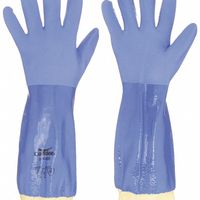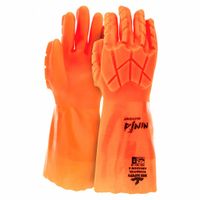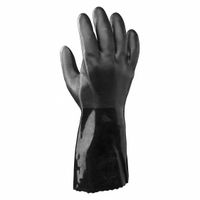Call +(254) 703 030 000 / 751 483 999 / 721 704 777
- Home
- Safety
- Hand Arm Protection
- Safety Gloves
- Chemical Resistant Gloves
.....Read More
Frequently Asked Questions
What are chemical-resistant gloves made of?
Chemical-resistant gloves are typically made from materials that provide a barrier against hazardous substances. Common materials include:
1. **Nitrile**: Known for its resistance to oils, fuels, and certain acids, nitrile gloves are a popular choice for handling chemicals. They offer good dexterity and are less likely to cause allergic reactions compared to latex.
2. **Neoprene**: This synthetic rubber is resistant to a wide range of chemicals, including oils, acids, and caustics. Neoprene gloves provide flexibility and are often used in laboratories and industrial settings.
3. **Butyl Rubber**: Butyl gloves offer excellent protection against gases and water vapor, as well as a variety of chemicals such as ketones and esters. They are often used in situations where high chemical resistance is required.
4. **PVC (Polyvinyl Chloride)**: PVC gloves are resistant to acids, bases, and alcohols. They are often used in food processing and chemical handling due to their durability and cost-effectiveness.
5. **PVA (Polyvinyl Alcohol)**: PVA gloves are highly resistant to aromatic and chlorinated solvents. However, they are water-soluble, so they are not suitable for use with water-based solutions.
6. **Viton**: Known for its resistance to a wide range of chemicals, including chlorinated and aromatic solvents, Viton gloves are used in highly specialized applications.
7. **Latex**: While natural rubber latex offers good elasticity and comfort, it is less resistant to chemicals compared to synthetic materials and can cause allergic reactions in some individuals.
Each material has its own strengths and limitations, and the choice of glove depends on the specific chemicals being handled, the duration of exposure, and the required level of dexterity and comfort.
How do I choose the right chemical-resistant gloves for my job?
1. **Identify the Chemicals**: Determine the specific chemicals you'll be handling. Refer to the Safety Data Sheets (SDS) for information on chemical properties and hazards.
2. **Assess Exposure Level**: Consider the duration and frequency of exposure. This will help determine the thickness and material of the gloves needed.
3. **Select Material**: Choose glove material based on chemical compatibility:
- **Nitrile**: Good for oils, greases, acids, and some solvents.
- **Neoprene**: Resistant to acids, bases, alcohols, and fuels.
- **PVC**: Suitable for acids, bases, oils, and fats.
- **Butyl**: Effective against gases and ketones.
- **Viton**: Offers protection against chlorinated and aromatic solvents.
4. **Check Permeation and Degradation**: Review permeation and degradation data to ensure the gloves provide adequate protection for the chemicals used.
5. **Consider Dexterity and Comfort**: Ensure the gloves allow for necessary dexterity and comfort, especially for tasks requiring precision.
6. **Evaluate Glove Thickness**: Thicker gloves offer more protection but may reduce dexterity. Balance protection with the need for tactile sensitivity.
7. **Size and Fit**: Choose the correct size for a snug fit to prevent slippage and ensure comfort.
8. **Inspect for Quality**: Check for any defects or damage before use. Ensure gloves meet relevant safety standards.
9. **Training and Compliance**: Ensure proper training on glove use and compliance with workplace safety regulations.
10. **Consult Experts**: Seek advice from safety professionals or manufacturers for specific recommendations.
11. **Trial and Feedback**: Conduct trials and gather feedback from users to ensure the gloves meet job requirements effectively.
Are chemical-resistant gloves reusable?
Yes, chemical-resistant gloves can be reusable, but it depends on several factors including the material of the gloves, the type of chemicals they are exposed to, and the manufacturer's guidelines.
Gloves made from materials like nitrile, neoprene, or butyl rubber are often designed for reuse, provided they are properly cleaned and maintained. After use, these gloves should be thoroughly washed with soap and water to remove any chemical residues. It's important to inspect them for any signs of degradation, such as cracks, tears, or discoloration, which can compromise their protective capabilities.
The type of chemical exposure is crucial in determining reusability. Some chemicals can degrade glove materials quickly, making them unsuitable for reuse. Always refer to the glove's chemical resistance chart to ensure compatibility with the substances being handled.
Manufacturers often provide specific instructions regarding the reuse of their gloves. These guidelines should be followed to ensure safety and effectiveness. In some cases, gloves may be labeled as single-use, especially if they are made from thinner materials or are intended for handling highly hazardous substances.
Ultimately, the decision to reuse chemical-resistant gloves should prioritize safety. If there is any doubt about the integrity of the gloves after cleaning, it is safer to dispose of them and use a new pair. Regular training and adherence to safety protocols are essential to ensure that gloves are used correctly and provide the necessary protection.
What chemicals can chemical-resistant gloves protect against?
Chemical-resistant gloves can protect against a wide range of chemicals, depending on the material they are made from. Here are some common glove materials and the chemicals they typically protect against:
1. **Nitrile**: Offers protection against oils, greases, petroleum products, some acids and caustics, and many solvents. It is a good general-purpose glove material.
2. **Latex**: Provides protection against biological hazards and water-based chemicals. However, it is not suitable for use with organic solvents and can cause allergic reactions in some individuals.
3. **Neoprene**: Effective against a broad range of acids, caustics, alcohols, and some solvents. It is also resistant to degradation from sunlight, ozone, and weather.
4. **Butyl Rubber**: Offers excellent protection against gases and water vapor, as well as ketones, esters, and highly corrosive acids. It is particularly effective against chemicals like nitric acid and sulfuric acid.
5. **Viton**: Provides high resistance to chlorinated and aromatic solvents. It is suitable for use with chemicals like benzene, toluene, and xylene.
6. **Polyvinyl Chloride (PVC)**: Protects against acids, bases, oils, fats, peroxides, and amines. It is not suitable for use with organic solvents.
7. **PVA (Polyvinyl Alcohol)**: Offers excellent resistance to aromatic and chlorinated solvents but is not suitable for use with water or water-based solutions.
8. **Silver Shield/4H**: Provides protection against a wide range of chemicals, including alcohols, aliphatic, aromatic, chlorinated solvents, ketones, and esters.
The effectiveness of chemical-resistant gloves depends on factors such as the concentration of the chemical, the duration of exposure, and the glove's thickness and integrity. Always consult the manufacturer's chemical resistance guide to ensure the gloves are suitable for the specific chemicals you are handling.
How do I properly care for and maintain chemical-resistant gloves?
To properly care for and maintain chemical-resistant gloves, follow these steps:
1. **Selection**: Choose gloves appropriate for the specific chemicals you'll be handling. Refer to the manufacturer's chemical resistance guide.
2. **Inspection**: Before each use, inspect gloves for signs of wear, such as cracks, punctures, or discoloration. Check seams and fingertips carefully.
3. **Cleaning**: After use, wash gloves with mild soap and water to remove any chemical residues. Rinse thoroughly and air dry. Avoid using solvents or harsh detergents.
4. **Storage**: Store gloves in a cool, dry place away from direct sunlight and heat sources. Keep them away from chemicals and sharp objects to prevent damage.
5. **Rotation**: If using gloves frequently, rotate pairs to allow them to dry completely between uses, which helps extend their lifespan.
6. **Replacement**: Replace gloves immediately if they show any signs of degradation or if they have been exposed to chemicals beyond their resistance capacity. Follow the manufacturer's guidelines for the expected lifespan of the gloves.
7. **Training**: Ensure all users are trained in the proper use and limitations of the gloves. They should understand the importance of selecting the right glove for the task.
8. **Documentation**: Keep records of glove inspections, cleaning, and replacement schedules to ensure compliance with safety protocols.
9. **Compatibility**: Be aware of the compatibility of gloves with other personal protective equipment (PPE) to ensure comprehensive protection.
10. **Disposal**: Dispose of gloves according to local regulations, especially if contaminated with hazardous chemicals.
By following these steps, you can ensure the longevity and effectiveness of chemical-resistant gloves, maintaining safety and compliance in the workplace.
Can chemical-resistant gloves provide protection against heat and cold?
Chemical-resistant gloves are primarily designed to protect against hazardous chemicals and solvents. Their ability to provide protection against heat and cold depends on the materials used in their construction.
1. **Heat Protection**:
- Chemical-resistant gloves made from materials like neoprene, nitrile, or butyl rubber generally offer limited heat resistance. They can protect against mild heat but are not suitable for high-temperature environments. For significant heat protection, gloves specifically designed for thermal resistance, such as those made from Kevlar or aluminized materials, are recommended.
2. **Cold Protection**:
- Some chemical-resistant gloves may offer basic cold protection, especially if they are thicker or have an insulated lining. However, they are not specifically designed for extreme cold conditions. For effective cold protection, gloves with thermal insulation, such as those made from Thinsulate or fleece, are more appropriate.
In summary, while chemical-resistant gloves can offer some degree of protection against heat and cold, they are not specifically designed for these purposes. For optimal protection, it is advisable to use gloves specifically engineered for thermal resistance in conjunction with chemical resistance if both hazards are present.
What is the difference between antistatic and regular chemical-resistant gloves?
Antistatic gloves and regular chemical-resistant gloves serve different purposes and are designed with distinct features to address specific needs.
Antistatic gloves are primarily designed to prevent static electricity buildup, which can damage sensitive electronic components. They are made from materials that dissipate static charges, such as carbon or copper fibers woven into the fabric. These gloves are essential in environments where static discharge could harm electronic devices or ignite flammable substances. They provide a controlled path for static electricity to dissipate safely, protecting both the wearer and the equipment.
On the other hand, regular chemical-resistant gloves are designed to protect the wearer from hazardous chemicals. They are made from materials like nitrile, latex, neoprene, or PVC, which provide a barrier against chemical penetration. The choice of material depends on the specific chemicals being handled, as different materials offer varying levels of resistance to different substances. These gloves are crucial in laboratories, industrial settings, or any environment where exposure to harmful chemicals is a risk.
In summary, the primary difference lies in their purpose and material composition. Antistatic gloves focus on preventing static discharge, using conductive materials to safely dissipate static electricity. Regular chemical-resistant gloves prioritize protection against chemical exposure, using materials that form a barrier against specific chemicals. While both types of gloves offer protection, they are not interchangeable and should be selected based on the specific hazards present in the work environment.





